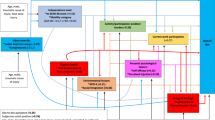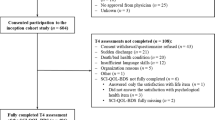Abstract
Study design:
Cross sectional.
Objectives:
To examine associations among functional status, health-related and individualised quality of life (QoL) and coping style in subjects with spinal cord injury (SCI).
Setting:
Italy.
Methods:
Forty subjects attending our hospital-based rehabilitation centre for SCI were administered the Spinal Cord Independence Measure-version III (SCIM-III), the Short Form-36 (SF-36), the Schedule for the Evaluation of Individual QoL-Direct Weighting (SEIQoL-DW) and the Coping Inventory for Stressful Situation (CISS) to assess functional status, health-related QoL, individualised QoL and coping strategies, respectively.
Results:
The SCIM-III scores were positively correlated (P<0.01) with the physical functioning subscale of the SF-36. The only scale that correlated (P<0.01) with the SEIQoL-DW scores was the SF-36 mental health subscale. Positive correlations among task-oriented or avoidance-oriented coping and specific measures of health-related QoL emerged.
Conclusions:
Data from the present study showed only a few associations among different measures of QoL and suggest that patient-centered evaluations of QoL are not necessarily or strictly related to functional status or health-related QoL. Coping strategies seem to be significantly related to the subjects perceptions of QoL, but mostly in the health-related domains.
Similar content being viewed by others
Log in or create a free account to read this content
Gain free access to this article, as well as selected content from this journal and more on nature.com
or
References
The WHOQoL Group. Protocol for New Centres. WHO. 1994.
Hill MR, Noonan VK, Sakakibara BM, Miller WC, and the SCIRE Research Team. Quality of life instruments and definitions in individuals with spinal cord injury: a systematic review. Spinal Cord 2010; 48: 438–450.
Carr AJ, Higginson IJ . Measuring quality of life: are quality of life measures patient centred? BMJ 2001; 322: 1357–1360.
Whalley Hammel K . Quality of life after spinal cord injury: a meta-synthesis of qualitative findings. Spinal Cord 2007; 45: 124–139.
McGee H . Quality of life. In Kaptein A, Weinman J (eds). Health Psychology. Blackwell: Malden. 2004 pp 234–257.
Mathew KM, Ravichandran G, May K, Morsley K . The biopsychosocial model and spinal cord injury. Spinal Cord 2001; 39: 644–649.
Galvin LR, Godfrey HPD . The impact of coping on emotional adjustment to spinal cord injury (SCI): review of the literature and application of a stress appraisal and coping formulation. Spinal Cord 2001; 39: 615–627.
Elfstrom M, Ryden A, Kreuter M, Taft C, Sullivan M . Relations between coping strategies and health-related quality of life in patients with spinal cord lesion. J Rehabil Med 2005; 37: 9–16.
Bonanno GA, Kennedy P, Galatzer-Levy IR, Lude P, Elfström ML . Trajectories of resilience, depression and anxiety following spinal cord injury. Rehabil Psychol 2012; 57: 236–247.
Kennedy P, Lude P, Elfström ML, Smithson EF . Psychological contributions to functional independence: a longitudinal investigation of spinal cord injury rehabilitation. Arch Phys Med Rehabil 2011; 92: 597–602.
Post MWM, van Leeuwen CMC . Psychosocial issues in spinal cord injury: a review. Spinal Cord 2012; 50: 382–389.
van Leeuwen CM, Kraaijeveld S, Lindeman E, Post MW . Associations between psychological factors and quality of life ratings in persons with spinal cord injury: a systematic review. Spinal Cord 2012; 50: 174–187.
Krause JS . Aging and life adjustment after spinal cord injury. Spinal Cord 1998; 36: 320–328.
Dijkers MPJM . Correlates of life satisfaction among persons with spinal cord injury. Arch Phys Med Rehabil 1999; 80: 867–876.
Itzkovich M, Gelernter I, Biering-Sorensen F, Weeks C, Laramee MT, Craven BC et al. The Spinal Cord Independence Measure (SCIM) version III: reliability and validity in a multi-center international study. Disabil Rehabil 2007; 29: 1926–1933.
Ware JE, Sherbourne CD . The MOS 36-item short-form health survey (SF-36). Conceptual framework and item selection. Med Care 1992; 30: 473–483.
O’Boyle CA, McGee HM, Hickey A, Joyce CRB, Browne J, O’Malley K et al. The Schedule for the Evaluation of Individual Quality of Life (SEIQoL). Administration Manual. Royal College of Surgeons in Ireland: Dublin. 1993.
Wettergren L, Kettis-Lindblad A, Sprangers M, Ring L . The use, feasibility and psychometric properties of an individualised quality-of-life instrument: a systematic review of the SEIQoL-DW. Qual Life Res 2009; 18: 737–746.
Effing TW, van Meeteren NL, van Asbeck FW, Prevo AJ . Body weight-supported treadmill training in chronic incomplete spinal cord injury: a pilot study evaluating functional health status and quality of life. Spinal Cord 2006; 44: 287–296.
Levack P, Graham J, Kidd J . Listen to the patient: quality of life of patients with recently diagnosed malignant cord compression in relation to their disability. Palliat Med 2004; 18: 594–601.
Endler NS, Parker JDA . Assessment of multidimensional coping: Task, emotion, and avoidance strategies. Psychol Assess 1994; 6: 50–60.
Kennedy P, Evans M, Sandhu N . Psychological adjustment to spinal cord injury: the contribution of coping, hope and cognitive appraisals. Psychol Health Med 2009; 14: 17–33.
Chevalier Z, Kennedy P, Sherlock O . Spinal cord injury, coping and psychological adjustment: a literature review. Spinal Cord 2009; 47: 778–782.
Thompson L, Yakura J . Aging related functional changes in persons with spinal cord injury. Top Spinal Cord Inj Rehabil 2006; 6: 69–82.
Author information
Authors and Affiliations
Corresponding author
Ethics declarations
Competing interests
The authors declare no conflict of interest.
Rights and permissions
About this article
Cite this article
Tramonti, F., Gerini, A. & Stampacchia, G. Individualised and health-related quality of life of persons with spinal cord injury. Spinal Cord 52, 231–235 (2014). https://doi.org/10.1038/sc.2013.156
Received:
Revised:
Accepted:
Published:
Issue date:
DOI: https://doi.org/10.1038/sc.2013.156



